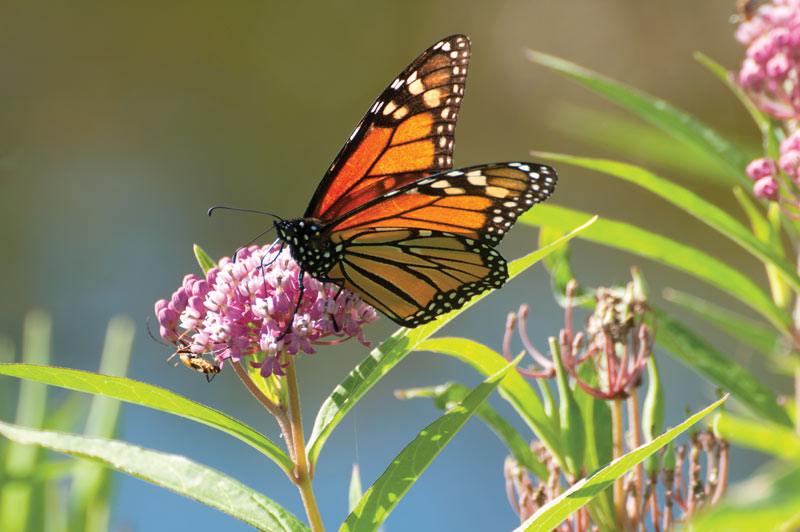
Cultivating native habitat that includes milkweed and various nectar sources will create an oasis where monarchs can reproduce in spring and summer and stop for much-needed nourishment as they travel south in fall. Shown here is swamp milkweed (Asclepias incarnata). Photo by Nancy Bauer/Shutterstock.com
From its hillside entrance speckled with purple coneflower and other pollinator pleasers to the 26 bluebird houses tucked throughout the grounds, Gustin Golf Course has distinguished itself as a multifaceted nature-friendly haven. The 18-hole public course, operated by the University of Missouri in the heart of Columbia, Mo., first achieved Certified Audubon Cooperative Sanctuary status in 1997 and has maintained the classification ever since.
So for GCSAA Class A superintendent Isaac Breuer, restoring out-of-play areas on the 150-acre property to native flora to support wildlife and pollinators was a logical step, and one he began pursuing about five years ago. It wasn’t until last June, though, when he attended a symposium on monarch butterflies presented at the university, that Breuer discovered he could assist these imperiled insects with just a simple addition to the golf course landscape.
“I learned monarch populations have declined 90 percent in the past 20 years, and a big cause is the lack of milkweed growing for them,” says Breuer, a 17-year member of GCSAA, who is in his 20th year at Gustin GC. “It got me thinking that if we could plant patches of milkweed on golf courses all throughout the monarch migration pattern, it could really help. Every golf course in the country has an area that’s out of play that they mow that they don’t need to mow — even just a quarter of an acre — that could be planted in milkweed for monarchs.”
The monarch butterfly’s annual 3,000-mile round-trip migration is a true marvel of the natural world. Every fall, populations head south to overwinter in Mexico, then return stateside in spring and stay through summer, during which time they reproduce. Because of the length of the monarch’s journey — most other butterflies never travel outside of about 20 miles — these flutterers need to stay fueled up via nectar-rich plants throughout the trip, and during their flight back north, monarchs require milkweed, the only plant their larvae eat.
Though their plight doesn’t get the press that bees’ receives, monarchs play a role as pollinators in their own right, and they’re also an important food source for small mammals, birds and insects, says Scott Hoffman Black, executive director of the Xerces Society, an international nonprofit dedicated to insect conservation. While such facts make the monarch’s downturn particularly worrisome, the good news, Black says, is that these dazzling creatures, though delicate of build, are actually quite tough. “They’re very resilient, and if we provide the habitat, they use it,” Black says. “Anybody can take action — a golf course, a homeowner — by putting in and maintaining a high-quality habitat.”
The ingredients necessary to that habitat are native milkweed and at least four nectar-producing flowers that, together, will furnish nectar from spring through fall. Milkweed is a perennial that takes about two years to establish, but after it gets going, it’s quite hardy. Choosing milkweeds native to your area limits the likelihood that plants will become invasive, Black says, and because native species are adapted to local conditions, they typically grow better.
Monarch refuges should be located in sunny areas. Although a larger space is more likely to attract monarchs, Black says any size is beneficial, as these butterflies can often sleuth out even small swaths of milkweed and sustenance. Black advises superintendents to invest time in preparing the site beforehand. If weeds haven’t been adequately eradicated, a monarch habitat may again become overrun with them in a few years. Superintendents should also try to allow some time to pass before developing a site where insecticides have been used. These preliminary considerations will promote a prolific and easy-to-manage habitat for the long term.
Pockets of native milkweed already existed around Gustin GC, but Breuer wanted to incorporate more, and has designated an out-of-play acre between the 10th, 11th and 18th holes that he hopes will eventually become a certified Monarch Waystation, a recognition given by the nonprofit education, conservation and research program Monarch Watch. (At least 28 North American golf courses are home to a certified Monarch Waystation.) The transformation will get underway at the end of this month, with a group of elementary school students visiting to help plant the native-milkweed-and-flower seed mix, which Breuer will supplement with milkweed transplants. “As part of the university, we’re also a learning institution,” says Breuer, who hopes the students will return in the years ahead to see the plot’s progress, fostering a relationship with nature and with the golf course.
“The unique thing about golf courses is that they have professional staff who really understand what they’re doing, so they can successfully manage these habitats for monarchs and become part of the solution,” says Black. “We’d love to see more of that.”
In return? Both superintendents and golfers will enjoy the company of these winged wonders, year after year.
For more information and to find a source for native milkweed and nectar-rich plants, visit the Xerces Society and Monarch Watch websites.
Megan Hirt is GCM’s managing editor.